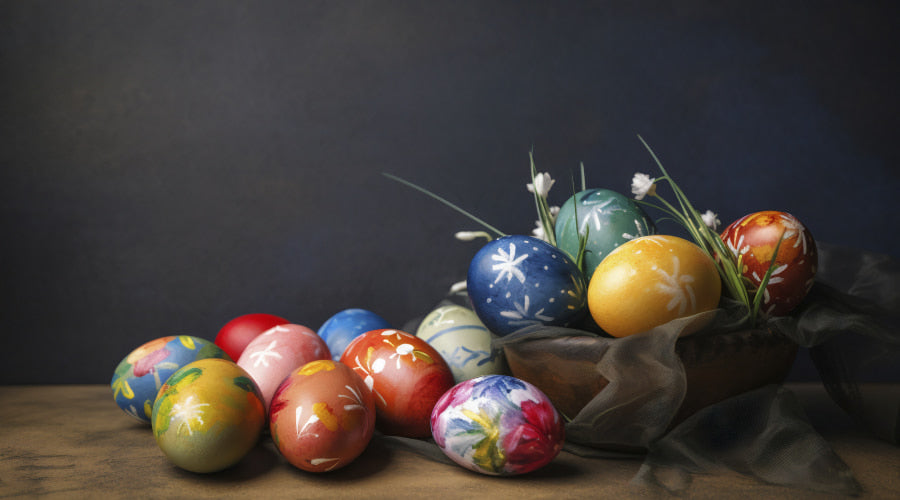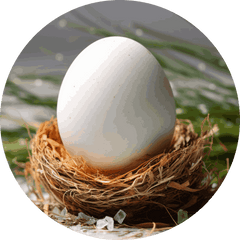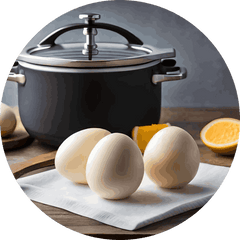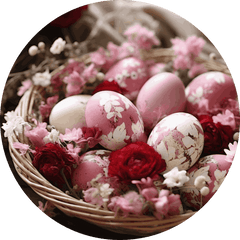How to Decorate Easter Eggs with Flowers?
Easter eggs with flowers add a delightful and whimsical touch to tradition. By incorporating nature's beauty into your egg adorning process, you can create stunning works of art. Whether you're a seasoned crafter or a beginner, doesn't matter. There are various techniques to explore, from simple floral patterns to intricate designs.
In this guide, we'll explore different methods for adorning eggs with flowers. We will provide step-by-step instructions, helpful tips, and creative ideas. They are to inspire your own artistic expression. Get ready to infuse your celebration with the beauty of nature and the joy of creativity!
The Charm of Easter Eggs with Flowers

Eggs adorned with flowers exude a charming allure. It blends the vibrancy of spring with the timeless tradition of egg decoration. Each delicate petal and intricate bloom adds a touch of natural elegance. It transforms simple eggs into miniature works of art. These eggs not only symbolize the renewal and fertility of the season. They also serve as delightful centerpieces or gifts. They spread joy and warmth during the festivities.
Materials for Floral Easter Egg Decorations
Here's a list of essentials:
- Eggs. Fresh, hard-boiled, or artificial eggs serve as the canvasю
- Fresh Flowers. Opt for delicate roses, daisies, or pansies.
- Dried Flowers. Preserved flowers such as lavender or baby's breath retain their color and shape.
- Paints. Acrylic or watercolor paints in assorted colors allow you to hand-paint intricate patterns.
- Brushes. Fine-tip brushes enable precise detailing and delicate strokes.
- Glue. Craft glue or Mod Podge adheres flowers and other embellishments to the floral Easter egg surface.
- Floral Stickers. They offer convenience and ease of application.
- Ribbon or Twine. Adding a bow or wrapping twine around the eggs adds a finishing touch.
- Varnish or Sealant. A protective coat of varnish or sealant preserves your floral decorations.
Creative Ideas for Decorating Easter Eggs

Egg adorning is a cherished tradition. It offers endless opportunities for creativity and self-expression. Unleash your imagination and experiment with these creative techniques. With them, you will craft eggs that are as unique and beautiful as they are fun to make. Explore these innovative ideas to elevate your egg decorating game this Easter:
|
Natural Dyeing Techniques |
Boil eggs with onion skins for a natural dye bath, resulting in beautiful earthy tones. Create vibrant yellow eggs by simmering them in a pot with turmeric powder. Boil red cabbage to extract a blue dye for coloring eggs, or add vinegar for a purple hue. Achieve a rich pink or red color by soaking eggs in beet juice. |
|
Botanical Impressions |
For this idea for decorating Easter eggs, press fresh flowers onto eggshells. Do it before dyeing for intricate floral patterns. Secure small leaves onto eggs with rubber bands. Do it before dyeing to create leaf-shaped designs. Lay herb leaves on dyed eggs, and gently rub with a cloth dipped in oil to reveal intricate patterns. |
|
Painted Masterpieces |
Use watercolor paints to create soft, dreamy designs reminiscent of watercolor paintings. Swirl different colors of paint in a bowl of water. Then dip eggs to achieve mesmerizing marble patterns. Apply small pieces of gold leaf to dyed eggs for a luxurious, shimmering effect. Dip a paintbrush in paint and flick it onto eggs for a fun and abstract look. |
How to Decorate Easter Eggs with Real Flowers?
Adorning eggs with real flowers adds a charming and natural touch. Follow these steps to adorn your eggs with the beauty of fresh blooms.
With these techniques, you can create beautifully adorned eggs using real flowers, blown or boiled eggs, dried roses, and plastic eggs, adding a touch of creativity and charm to your holiday celebrations.

How to Blow an Egg for Decorating?
This Easter egg decoration option is very popular because such decorations for Easter can last for several years and not get spoiled. It is made from empty eggs when all egg contents (white and yolk) are blown out of the shell through small holes at the top and bottom. So, how do you blow eggs for decorating?
- First, choose the right eggs, medium-sized, without cracks or chips.
- Next, you need to empty the egg of its contents. To do this, tape the top and bottom sides of the egg (this will keep the egg from cracking) and make small holes with a stationery button on both sides.
- Blow into one of the holes to allow the contents of the egg to come out of the second hole.
- Rinse the eggshell well, and let it dry overnight.
- That's it, your eggs are ready, and you can start decorating them.

How to Boil an Egg for Decorating?
Another option that can be used is boiled eggs. While blown eggs are used more as decoration, boiled eggs can be placed on the table and then eaten. Moreover, Christians have a tradition of "egg fight", when two people tap each other's eggs, and whoever breaks loses. It is more of a pastime but is used very often on this holiday. We want to tell you how to boil an egg for decorating.
- Pick up the eggs and a pot of suitable size. Fill the eggs with water to cover them and it is about 2 cm higher.
- Add salt or vinegar, this will help prevent the eggs from cracking the shells.
- Bring the water to a boil, then turn off the stove and leave the eggs to boil for another 10-12 minutes.
- Then drain the hot water and hold the boiled eggs under cold running water.
- Once the shells have cooled, you can start decorating the eggs.

Easter Eggs Decorating with Dried Roses
What could be more beautiful than flowers? Roses are such beautiful but, at the same time, quite discreet and austere flowers. Did you know that dried roses can also be used to decorate eggs? You may have a question about how to decorate easter eggs with dried roses, and is it possible at all? And our answer is - it is possible!
Eggs decorated with dried roses are simple and tasteful, beautiful, gentle, and original. All you need to make them is the eggs (raw), dried roses, and a pot of water. Rosaholics will help you to get the best roses, there you can find the best option for you.
- The first thing you should do is crush dried rose petals.
- Then, put the petals in a pot, top the eggs, and pour the water to cover them completely.
- Put the pot on the stove and bring it to a boil.
- Turn off the heat and let the eggs simmer for another 10-12 minutes.
- After a time, take out the cooked and decorated eggs with beautiful pearlescent color and blot them with a napkin. Just be careful, they're still hot!

You can use roses not only in red color. Rosaholics offers a large selection of colored roses, including green, blue, and even black roses for your Easter egg decoration design. This will help you paint your eggs in other shades as well.
So, you not only boiled the eggs but also decorated them at the same time.
That's not the end of the story, we also have a second option on how to decorate easter eggs with dried roses.
- Take gauze, and spread it on the table. Soak the eggs in water and put them on the gauze, sprinkling them with crushed rose petals.
- Carefully tie up the gauze, leaving the eggs as if in a sack.
- Put them in a pot with water and boil as usual.
In this way, you will have an even more original and unique pattern, which you will achieve using roses. We think that this is the best paint to decorate eggs - natural and beautiful.

How to Decorate Plastic Easter Eggs?
To adorn plastic eggs, start by cleaning them with a damp cloth to remove any dirt or debris. Apply adhesive, like craft glue or double-sided tape, to the surface. Next, add embellishments such as stickers, ribbons, sequins, or flowers. Do it according to your desired design. If you prefer, use acrylic paint to add colorful designs or patterns. Additionally, you can adorn with markers, glitter, or gems for added flair. Allow the adorned plastic eggs to dry completely before handling or displaying them. With these simple steps, you can create beautifully adorned plastic eggs.
Advanced Techniques for Floral Easter Eggs

Take your egg skills to the next level with these advanced techniques. They incorporate intricate floral designs:
- Wax Resist Method. Use the ancient art of batik. Apply melted wax to eggs in intricate floral patterns before dyeing. The wax creates a barrier. It preserves the natural eggshell color in the areas covered. While it allows dyes to penetrate elsewhere. After dyeing, gently remove the wax to reveal stunning, multi-layered designs.
- Embroidered Eggs. Channel your inner seamstress by adorning eggs with delicate embroidery. Pierce small holes in the eggshell. And carefully stitch floral motifs using fine embroidery thread. Experiment with different stitches and techniques such as satin stitch, French knots, and seed stitches. It's to create intricate, textured Easter egg decoration designs.
- 3D Floral Appliqué. Create dimension and depth on your eggs with 3D floral appliqué. Craft tiny fabric or paper flowers and. Adhere them to the eggshell using strong glue or decoupage medium. Layer different sizes and shapes to achieve a realistic, textured effect. And add embellishments like beads or sequins for extra flair.
Conclusion
Adorning offers a wonderful opportunity to express creativity and celebrate the season. Whether using real flowers, intricate techniques, or simple embellishments doesn't matter. Each adorned egg becomes a unique symbol of renewal and festivity. It adds warmth and charm to festivities.
carrusel_1
FAQ
Previously, when eggs were in red, it was a tribute to Jesus Christ. Now, it's more of a way to bring the family together for an interesting activity.
It’s believed that people associate hare with the goddess of spring revival of life and fertility.
You can use fresh flowers to decorate eggs. However, it's important to ensure that the flowers are non-toxic and safe for use with food. However, keep in mind that the flowers may wilt over time. It's especially true if the eggs are not kept refrigerated.
Yes, there are several of them. One approach is to use pre-dried or artificial flowers. They can be easily glued onto the eggs using non-toxic craft glue. Alternatively, children can create flower patterns on eggs using non-toxic markers or paints. Another option is to use flower-shaped stickers or decals to decorate the eggs.
Not seen your shipping location? We deliver US Nationwide, visit our Shop All collection to discover the perfect bouquet that best fit your occasion.













